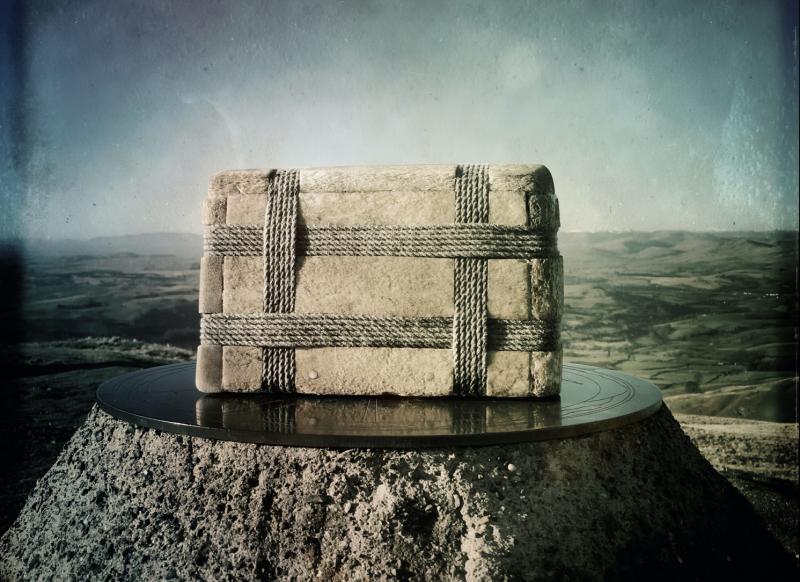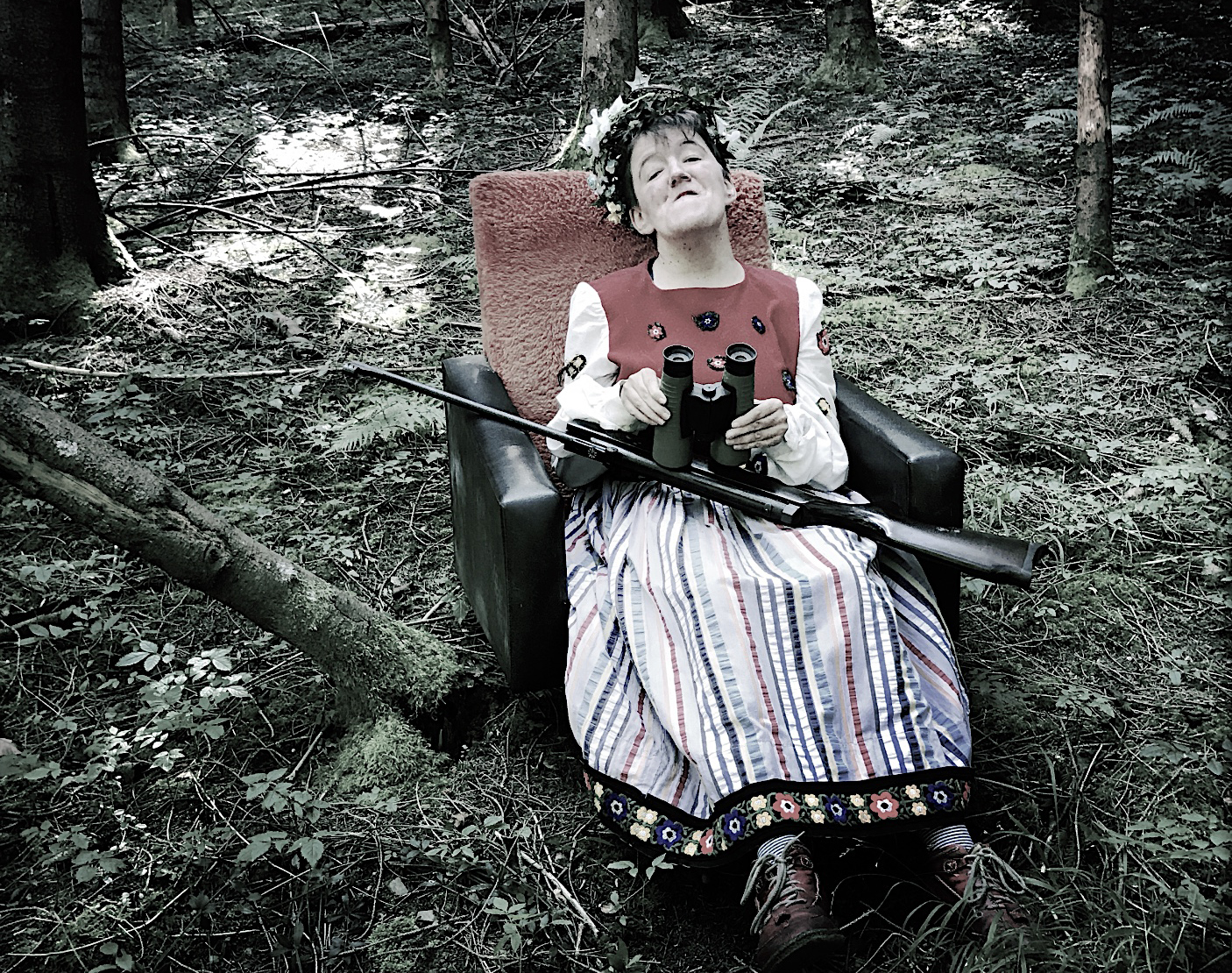The Whalebone Box review - documentary through unreliable surrealism | reviews, news & interviews
The Whalebone Box review - documentary through unreliable surrealism
The Whalebone Box review - documentary through unreliable surrealism
A different kind of road trip with artist Andrew Kötting

The UK-wide lockdown has thrown the cinematic release schedule into chaos. Some films are postponed indefinitely, while others have opted for direct digital releases. It’s not ideal for anyone, but in a strange way it may play to The Whalebone Box’s favour. Specialist arthouse streaming service MUBI has secured the exclusive rights, and their captive subscribers are the ideal audience for such a strange, hypnotic piece.
Experimental artist and filmmaker Andrew Kötting has built a reputation for idiosyncratic documentaries, and The Whalebone Box is true to form. Essentially, the plot follows Kötting, writer Iain Sinclair, and photographer Anonymous Bosch as they travel from London to Tarbert, off the west of Scotland, in possession of a box. It was crafted from the bones of a beached whale, and gifted to Sinclair by its sculptor Steve Dilworth. Their intention is to return it to the sands from which it came. But this is no fly-on-the-wall road trip. It's presented as a half-remembered fever dream, spilling from the conscious of Kötting’s daughter Eden (pictured above), an artist in her own right. She tries to piece together the story from fragments of footage, which get lost between her own hunt for a whale in the forest. The further north the group travel, the more distracted the account becomes. As the narration says, the box devours narrative like a black hole.
But this is no fly-on-the-wall road trip. It's presented as a half-remembered fever dream, spilling from the conscious of Kötting’s daughter Eden (pictured above), an artist in her own right. She tries to piece together the story from fragments of footage, which get lost between her own hunt for a whale in the forest. The further north the group travel, the more distracted the account becomes. As the narration says, the box devours narrative like a black hole.
The film conjures images from paganistic folklore. They take the box to various locations on the journey, from graveyards to mountains, imbuing it with ancient energy. But the deeper we get, the less reliable the story becomes. Why does the box change in appearance? How did they stop by the Pyrenees on their journey to Scotland? And who is that voice analysing the film’s imagery? It’s as if the box’s energy warps the very reality of the footage it's filmed on. How else can you explain the reflection of mobile phones as they shoot on 16mm?
Kötting is a master of soundscapes, and The Whalebone Box is equal parts impressive and unnerving. The wails of a mermaid merge with archive audio on aircraft black boxes, with approaching deep drones lurking underneath. Paired with images that bulge and sway, it builds the box’s mystique as this unknowable, powerful force of nature.
A star rating for a film like this is almost redundant. Its very nature is to subvert, confuse and disturb. It’s not an easy watch and not designed for mass appeal. But it is fascinating, surprising and strangely charming. For MUBI subscribers, worth a taste, just to see if you are the right audience.
rating
Explore topics
Share this article
The future of Arts Journalism
You can stop theartsdesk.com closing!
We urgently need financing to survive. Our fundraising drive has thus far raised £49,000 but we need to reach £100,000 or we will be forced to close. Please contribute here: https://gofund.me/c3f6033d
And if you can forward this information to anyone who might assist, we’d be grateful.

Subscribe to theartsdesk.com
Thank you for continuing to read our work on theartsdesk.com. For unlimited access to every article in its entirety, including our archive of more than 15,000 pieces, we're asking for £5 per month or £40 per year. We feel it's a very good deal, and hope you do too.
To take a subscription now simply click here.
And if you're looking for that extra gift for a friend or family member, why not treat them to a theartsdesk.com gift subscription?
more Film
 theartsdesk Q&A: director Kelly Reichardt on 'The Mastermind' and reliving the 1970s
The independent filmmaker discusses her intimate heist movie
theartsdesk Q&A: director Kelly Reichardt on 'The Mastermind' and reliving the 1970s
The independent filmmaker discusses her intimate heist movie
 Blu-ray: Wendy and Lucy
Down-and-out in rural Oregon: Kelly Reichardt's third feature packs a huge punch
Blu-ray: Wendy and Lucy
Down-and-out in rural Oregon: Kelly Reichardt's third feature packs a huge punch
 The Mastermind review - another slim but nourishing slice of Americana from Kelly Reichardt
Josh O'Connor is perfect casting as a cocky middle-class American adrift in the 1970s
The Mastermind review - another slim but nourishing slice of Americana from Kelly Reichardt
Josh O'Connor is perfect casting as a cocky middle-class American adrift in the 1970s
 Springsteen: Deliver Me From Nowhere review - the story of the Boss who isn't boss of his own head
A brooding trip on the Bruce Springsteen highway of hard knocks
Springsteen: Deliver Me From Nowhere review - the story of the Boss who isn't boss of his own head
A brooding trip on the Bruce Springsteen highway of hard knocks
 The Perfect Neighbor, Netflix review - Florida found-footage documentary is a harrowing watch
Sundance winner chronicles a death that should have been prevented
The Perfect Neighbor, Netflix review - Florida found-footage documentary is a harrowing watch
Sundance winner chronicles a death that should have been prevented
 Blu-ray: Le Quai des Brumes
Love twinkles in the gloom of Marcel Carné’s fogbound French poetic realist classic
Blu-ray: Le Quai des Brumes
Love twinkles in the gloom of Marcel Carné’s fogbound French poetic realist classic
 Frankenstein review - the Prometheus of the charnel house
Guillermo del Toro is fitfully inspired, but often lost in long-held ambitions
Frankenstein review - the Prometheus of the charnel house
Guillermo del Toro is fitfully inspired, but often lost in long-held ambitions
 London Film Festival 2025 - a Korean masterclass in black comedy and a Camus classic effectively realised
New films from Park Chan-wook, Gianfranco Rosi, François Ozon, Ildikó Enyedi and more
London Film Festival 2025 - a Korean masterclass in black comedy and a Camus classic effectively realised
New films from Park Chan-wook, Gianfranco Rosi, François Ozon, Ildikó Enyedi and more
 After the Hunt review - muddled #MeToo provocation
Julia Roberts excels despite misfiring drama
After the Hunt review - muddled #MeToo provocation
Julia Roberts excels despite misfiring drama
 Ballad of a Small Player review - Colin Farrell's all in as a gambler down on his luck
Conclave director Edward Berger swaps the Vatican for Asia's sin city
Ballad of a Small Player review - Colin Farrell's all in as a gambler down on his luck
Conclave director Edward Berger swaps the Vatican for Asia's sin city
 London Film Festival 2025 - Bradley Cooper channels John Bishop, the Boss goes to Nebraska, and a French pandemic
... not to mention Kristen Stewart's directing debut and a punchy prison drama
London Film Festival 2025 - Bradley Cooper channels John Bishop, the Boss goes to Nebraska, and a French pandemic
... not to mention Kristen Stewart's directing debut and a punchy prison drama
 London Film Festival 2025 - from paranoia in Brazil and Iran, to light relief in New York and Tuscany
'Jay Kelly' disappoints, 'It Was Just an Accident' doesn't
London Film Festival 2025 - from paranoia in Brazil and Iran, to light relief in New York and Tuscany
'Jay Kelly' disappoints, 'It Was Just an Accident' doesn't

Add comment